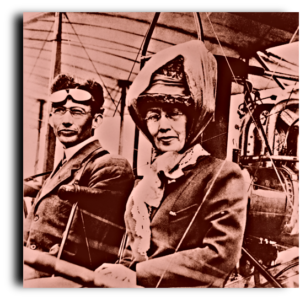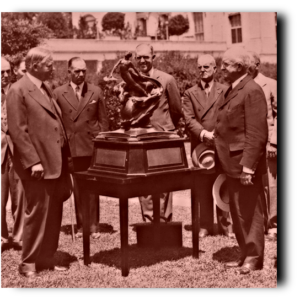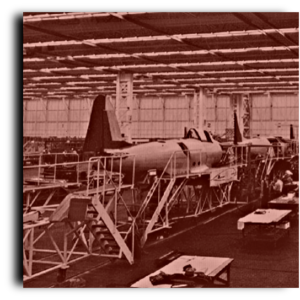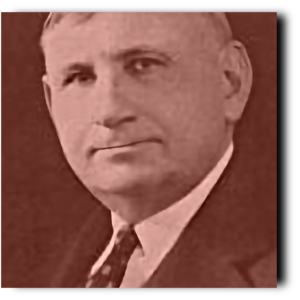BASIC OVERVIEW
The Martin-Collier-Phillips Corporation is an American defense, aerospace, medical, and information technology manufacturer and service specialist with worldwide interests. The Martin-Collier Company was formed on March 5th, 1930 from the remnants of the Glenn L Martin Company when the latter moved to Maryland in 1929, with the Cleveland location continuing through Glenn L Martin’s younger cousin Jonathan “Jack” Martin and an investment from Sara Steward Van Alen, the widow of Robert J Collier and member of the prominent Astor family, in memory of her late husband’s strong interest in aviation. It later expanded to the Martin-Collier-Phillips Corporation in 1960 with a push into the medical industry with a partnership with citrus magnate Dr. Philip Phillips and his son Howard Phillips.
It still remains headquartered in Cleveland, OH — near the Cleveland Hopkins International Airport. Currently, MCPC employs around 20,000 workers worldwide and has locations across the United States with several hubs internationally.
NOT SO HUMBLE BEGINNINGS
 On April 12th, 1896, Jonathan "Jack" Martin, Jr. was born in Salina, KS to Jonathan Martin, Sr and Sarah Martin (née Oswald). His father worked on a wheat farm with his brother Clarence Martin; his mother died during child birth. Due to his mother's passing, Jack Martin was often cared for by his Uncle Clarence's wife Minta Martin and became very close to his older cousin Glenn L. Martin. Heavily encouraged by Minta, young Glenn would become fascinated with the emerging aircraft technology -- often taking over the family's kitchen with kites and functioning models of early airplanes from innovators like the Wright Brothers and Glenn Curtiss. As Jack would describe, "Glenn had an unwavering passion and creative ingenuity for aeroplanes. I was neither as passionate nor as ingenious, but being ten years younger, I certainly had a great deal of awe for my cousin. Had Glenn been interested in cabinet making, I'd probably be a cabinet maker. Had he been interested in painting, I'd probably be a painter."
On April 12th, 1896, Jonathan "Jack" Martin, Jr. was born in Salina, KS to Jonathan Martin, Sr and Sarah Martin (née Oswald). His father worked on a wheat farm with his brother Clarence Martin; his mother died during child birth. Due to his mother's passing, Jack Martin was often cared for by his Uncle Clarence's wife Minta Martin and became very close to his older cousin Glenn L. Martin. Heavily encouraged by Minta, young Glenn would become fascinated with the emerging aircraft technology -- often taking over the family's kitchen with kites and functioning models of early airplanes from innovators like the Wright Brothers and Glenn Curtiss. As Jack would describe, "Glenn had an unwavering passion and creative ingenuity for aeroplanes. I was neither as passionate nor as ingenious, but being ten years younger, I certainly had a great deal of awe for my cousin. Had Glenn been interested in cabinet making, I'd probably be a cabinet maker. Had he been interested in painting, I'd probably be a painter."
Glenn went on to found the Glenn L Martin Company in 1912 in Santa Ana, CA to build military training aircraft. It eventually merged with the original Wright Company (forming the Wright-Martin Company). The merger was not successful (with the business failing by 1919), so Glenn left and formed a second Glenn L Martin Company in 1917 in Cleveland, OH. At the age of 21, Jack Martin joined his older cousin in Cleveland. From 1917-1929, Jack helped his cousin in producing aircraft for the US military -- often designed by other corporations -- faster and more affordably. The Industrial Bureau (known today as the Bureau of Industry and Security) pushed for the Glenn L Martin Company to relocate to Maryland starting in 1925, and in 1929, Glenn Martin made the decision to do so. Through a series of mergers and acquisitions, the Glenn L Martin Company would eventually become the Martin Marietta Corporation before finally becoming the Lockheed Martin Corporation in 1995 -- today, one of the largest government contractors in the country.
 Jack Martin didn't follow his cousin to Maryland, however. He got married to his wife Rebecca in 1920, and by 1921, they had the first of four children (a fifth child died in infancy). Jack had initially hoped to maintain the Cleveland manufacturing plant as he'd grown strong roots in the area, but Glenn Martin decided to sell the facility instead. For a time, there was a great deal of uncertainty for Jack Martin's career path. However, in 1930, he gained an unexpected financial backing to found his own aviation company: Sara Steward Van Alen.
Jack Martin didn't follow his cousin to Maryland, however. He got married to his wife Rebecca in 1920, and by 1921, they had the first of four children (a fifth child died in infancy). Jack had initially hoped to maintain the Cleveland manufacturing plant as he'd grown strong roots in the area, but Glenn Martin decided to sell the facility instead. For a time, there was a great deal of uncertainty for Jack Martin's career path. However, in 1930, he gained an unexpected financial backing to found his own aviation company: Sara Steward Van Alen.
Before the merger with Glenn L Martin's initial company, the Wright Company had formed in 1909 -- with its headquarters in New York and manufacturing facilities in Dayton, OH. A close friend of Orville Wright and director of the Wright Company was Robert J. Collier. Collier was the son of Peter Fenelon Collier -- a periodical publishing magnate. While having no design insight of his own, Robert J. Collier was an avid aviation enthusiast and one of the early presidents of the Aero Club of America -- an incubator for aeronautical innovation. Collier would be the namesake of the annual Collier Trophy -- an award for "the greatest achievement in aeronautics or astronautics in America, with respect to improving the performance, efficiency, and safety of air or space vehicles, the value of which has been thoroughly demonstrated by actual use during the preceding year."
Robert J. Collier died of a heart on November 8th, 1918 -- just days before the end of World War I. Sara Steward Van Alen, Collier's widow and a member of the prominent Astor family, had developed a good friendship with the Martins, and wishing to honor her late husband, when Glenn L Martin moved to Maryland, Van Alen offered investment funds to Jack Martin. Thus, on March 5th, 1930, the Martin-Collier Aircraft Company formed in Cleveland, OH.
TRIAL BY FIRE
 Jack Martin had largely missed the years of World War I that led the initial surge of aeronautic technology. However, things would start to change by the mid-1930s. With tensions in Europe increasing with the rise of Adolf Hitler in Germany and Benito Mussolini in Italy, the US began ramping up its spending in defense technology -- with many of today's large contractors getting their first real test. Although the United States was not yet officially in the war, entry into battle seemed imminent and the country was still supplying European Allies unofficially. With the coming of the war, the Martin-Collier Aircraft Company answered the call.
Jack Martin had largely missed the years of World War I that led the initial surge of aeronautic technology. However, things would start to change by the mid-1930s. With tensions in Europe increasing with the rise of Adolf Hitler in Germany and Benito Mussolini in Italy, the US began ramping up its spending in defense technology -- with many of today's large contractors getting their first real test. Although the United States was not yet officially in the war, entry into battle seemed imminent and the country was still supplying European Allies unofficially. With the coming of the war, the Martin-Collier Aircraft Company answered the call.
With the United States officially entering World War II in 1941 following the bombing of Pearl Harbor, demand for more weapons and vehicles -- with greater and greater innovation -- skyrocketed. The Martin-Collier Aircraft Company developed several of its key aircraft, like the B-87. However, as companies like Lockheed and the familiar Martin Corporation could manufacture the crafts cheaper, Martin-Collier decided to focus primarily on the engines and turbines to supplement other company's aircraft. Several prestigious plane models carried Martin-Collier engines as they flew into battle.
World War II officially ended in 1945, and the year prior, President Franklin D. Roosevelt signed the 1944 GI Bill -- designed to provide education and training for returning troops to be better equipped for re-entry into the workforce. In response to the GI Bill, Martin-Collier began hiring at a rapid pace and offering training programs for returning soldiers -- paving way for future engineers, fabricators, and assembly specialists.
THE SECONDHAND GIANT
 The 1950s saw the first major shift of the emerging defense contractor -- moving from aerospace and weapons technology into the medical industry. While the aviation industry was going through its early start, a man named Philip Phillips -- a medical doctor from New York -- was heading down to Florida. While he initially struggled, Dr. Phillips eventually developed several extensive citrus orchards around the Orlando area. Making millions from the orchards -- particularly once he sold off much of his land to Granada Grove and Minute Maid -- Dr. Phillips returned to his medical roots. He established a massive charitable network of hospitals, clinics, and funded for medical research. While Dr. Phillips died in 1959, his sons -- particularly, Howard Phillips -- took over and brought hefty investments to Martin-Collier's medical division. By 1960, the company held its final name: the Martin-Collier-Phillips Corporation.
The 1950s saw the first major shift of the emerging defense contractor -- moving from aerospace and weapons technology into the medical industry. While the aviation industry was going through its early start, a man named Philip Phillips -- a medical doctor from New York -- was heading down to Florida. While he initially struggled, Dr. Phillips eventually developed several extensive citrus orchards around the Orlando area. Making millions from the orchards -- particularly once he sold off much of his land to Granada Grove and Minute Maid -- Dr. Phillips returned to his medical roots. He established a massive charitable network of hospitals, clinics, and funded for medical research. While Dr. Phillips died in 1959, his sons -- particularly, Howard Phillips -- took over and brought hefty investments to Martin-Collier's medical division. By 1960, the company held its final name: the Martin-Collier-Phillips Corporation.
With its history of famous relatives and fortune heirs, in 1961 it was dubbed the "Secondhand Giant."
EXPANDING THROUGH THE YEARS
With the Cold War in full swing by this point, more and more high-end, and very secretive, technology was developed at MCPC including a special stealth bomber prototype known as the Y-457 that, while it never actually went beyond the prototype stage, was seen as the most advanced aircraft of the decade.
MCPC continued its expanse within the medical industry on into the 1970s, with multiple clinics opening across the country (currently, at least one clinic in every state). With advances in devices such as pacemaker technology, MCPC became a forefront authority on research and development, as well as a sort of starting point for many prominent minds. Franz Schindler, for example, was once a junior executive at MCPC before traveling back to his home country of Germany to help in re-inventing Fresenius with Else Kroner (daughter of Eduard Fresenius). The Fresenius company brings in billions of dollars per year now.
In 1977, the Martin-Collier-Phillips Corporation gained its 400th patent for the adoption heating-cooling system.
With powerhouses like IBM, and later Apple and Microsoft, emerging more and more profoundly, MCPC took a digital leap and started engaging in information technology services in the 1980s. By 1986, MCPC had one of the most advanced computer laboratories of the time. MCPC worked extensively with the Science Applications International Corporation (SAIC) and then Leidos when SAIC spun-off into that brand. Today, the Van Alen Center (VAC) in Newark, NJ operates one of the most powerful data centers on the east coast.
In 1994, MCPC opened two new facilities: one in Wilmington, NC (focusing on naval manufacturing) and the other in Montana (taking over the national security and cybersecurity monitoring and training). With larger areas to operate, major manufacturing facilities and hangars were built, and MCPC saw its largest growth ever -- going from around 4000 employees in three locations to over 10,000 employees within a couple of years.
Today, the Martin-Collier-Phillips Corporation still remains headquartered in Cleveland, OH — near the Cleveland Hopkins International Airport. Currently, MCPC employs just under 20,000 workers worldwide and has locations across the United States with several hubs and clinics internationally.

